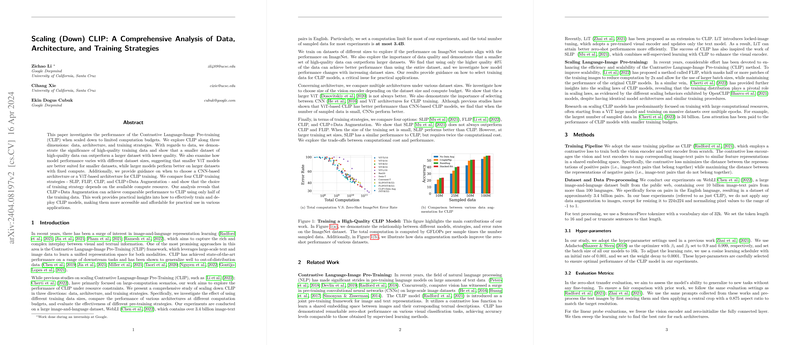Scaling Down CLIP: An In-depth Analysis of Data, Architecture, and Training Strategies
Introduction
Contrastive Language-Image Pre-training (CLIP) has emerged as a state-of-the-art framework in the domain of image and language representation learning, demonstrating exceptional performance across a variety of downstream tasks. However, the exploration of CLIP's efficacy under constrained computational resources remains largely unexplored. This paper presents a comprehensive paper focusing on the scaling down of CLIP across three critical dimensions: data, architecture, and training strategies. This research endeavors to provide actionable insights into optimizing CLIP's training and deployment in scenarios bounded by computational budgets, thereby broadening its applicability.
Scaling Data: Quantity, Quality, and Impact
The paper meticulously explores the interplay between data quantity and model performance, making several key observations:
- Data Quantity: The investigations reveal that the model's performance on ImageNet and its variants is significantly influenced by dataset size and the number of training epochs. Notably, while larger datasets benefit from increased training epochs, smaller datasets do not exhibit marked improvements beyond a certain point.
- Data Quality: A surprising insight from the paper highlights the importance of data quality. It was found that models trained on a smaller subset comprising the top 40% of high-quality data outperformed those trained on the entire dataset. This underscores the critical impact of data quality on model performance, suggesting that data curation strategies focusing on quality could lead to more effective training than merely increasing data quantity.
Exploration of Architectures
This section of the paper explores the comparison between CNN and ViT (Vision Transformer) architectures for CLIP training, elucidating how different architectures fare under various dataset sizes:
- The findings suggest that CNN architectures may exhibit superior performance on smaller datasets due to their inherent local structure bias, whereas ViT architectures outshine on larger data scales.
- An intriguing observation is that larger ViT models do not always guarantee better performance, especially when the data scale is limited, hinting at a nuanced relationship between architecture effectiveness and dataset size.
Training Strategies and Their Trade-offs
The comparison among several CLIP training strategies reveals nuanced trade-offs between computational cost and model performance:
- The paper comparatively assesses SLIP, FLIP, CLIP, and CLIP+Data Augmentation strategies, finding that the efficacy of each strategy varies with the available computational budget.
- Particularly, CLIP+Data Augmentation emerges as a promising strategy, achieving comparable performance to the vanilla CLIP model with significantly reduced data requirement, thereby offering a cost-efficient alternative for training CLIP models.
Implications and Future Directions
- Practical Deployment: The insights from this paper have profound implications for deploying CLIP in resource-constrained environments, suggesting pathways to maintain or even enhance performance without proportional increases in computational demand.
- Theory of Scale in AI Models: The observations contribute to the broader discourse on the scalability of AI models, challenging the prevailing notion that larger models and datasets invariably lead to better performance. Instead, they advocate for a nuanced approach that balances data quality, model architecture, and training strategies.
- Future Research: There's an avenue for further exploration into dynamic training strategies that adaptively adjust the architecture and training regimen based on the evolving quality and quantity of training data. Additionally, investigating the transferability of these insights to other domains of AI could unveil universal principles of scalable model training.
In conclusion, this paper not only provides comprehensive analysis and practical insights into scaling down CLIP models but also opens up new vistas for research into efficient model training paradigms. The nuanced understanding of how data management, architectural choices, and training strategies interact to affect model performance could significantly influence future developments in the field of artificial intelligence.
